Some of us will always associate Jeff Lemire with his award-winning trilogy Essex County, but in the years since he finished that project, Lemire has been an incredibly prolific creator. He wrote and drew most of the entire run of Sweet Tooth, his Vertigo series which ran for 40 issues. He’s written and drawn comics and graphic novels like The Nobody, Underwater Welder, Trillium, The Roughneck, and Royal City.
As a writer, Lemire has worked for multiple companies, writing Justice League and X-Men, Bloodshot and Animal Man, Old Man Logan and Green Arrow, and many more. He’s also written a long line of award-winning creator owned comics for other artists including Descender, Gideon Falls, and Plutona.
One series that has really taken off, and has managed to be a deeply personal series for Lemire even as it’s a superhero story, of a sort, is Black Hammer. The series drawn by Dean Ormston launched at Dark Horse in 2016. In between the main series, Lemire has written a number of spinoffs including Sherlock Frankenstein and the Legion of Evil, Cthu-Louise, and Doctor Star and the Kingdom of Lost Tomorrows with different artists. He’s also tackled the future of the universe in The Quantum Age and let Ray Fawkes and Matt Kindt tell stories in Black Hammer ’45.
This summer, Lemire wraps up Black Hammer: The Age of Doom with issue #12, though as Lemire made clear in an interview with The Beat, this issue is far from the end of the saga or these characters. In addition, the series is crossing over with the Justice League, and Dark Horse is releasing The World of Black Hammer Encyclopedia. Lemire also has a new series with artist Mike Deodato, Berserker Unbound.
Read on for a conversation between The Beat and Jeff Lemire about superheroes, his collaborations with creators and publishers, and more.
Alex Dueben: I’m curious, what are the superhero comics you really liked when you were younger? Or, what are the ones that have stayed with you?
Jeff Lemire: For me it really started with DC. I was 9 years old in 1985 and that was a hugely influential period for me. Both Crisis on Infinite Earths and DC’s original Who’s Who started that year and they hit me hard. I became obsessed with the scope and scale of the DC universe then and all the various Earths. I also really fell in love with Wolfman and Perez and The New Teen Titans. Giffen and Levitz’s Legion was also a big one.
I bought anything I could find. We didn’t have comic book stores, just newsstands, so I would really buy anything I could and I couldn’t be picky about it. I bought a lot of Marvel stuff then too, but it was really the DC stuff that hit and that I continued to collect as I got older. As the late 80s hit and DC started publishing a lot more experimental stuff (from Dark Knight, Swamp Thing, etc.) I was the perfect age for all that stuff to make a big impact.
So, basically anything and everything DC published between ’84 and ’91 was my sweet spot. I was between the age of eight and fifteen then. Formative years for sure. In terms of Marvel stuff, I was really into the Mark Gruenwald Captain America and the Iron Man stuff in that period as well.
But really DC’s Who Who was my bible. I knew that thing inside out. Still do.
Dueben: You wrote in the back of the first Black Hammer collection about how you had started writing this idea when you were finishing Essex County back in 2007-8. Back then did you have this entire story laid out in your mind, story beats, beginning middle end?
Lemire: Not at the same scope it ended up being. I had the initial set-up and most of the main cast and I had a very loose idea of where it might end, but it was never fully developed beyond character designs and histories and initial ideas. And many of those changed when I returned to it in 2014. The character of Lucy Weber, for example, was not a part of that early incarnation, and for me she was the key that unlocked the whole story. She is the heart of the whole universe now.
I can’t fully remember how I thought it would end back then, but I know I have sketch books and notebooks with stuff in them somewhere.
Dueben: Is that how you like to work and think about story? You need all of it in your mind – even if it may change? Or does that vary from project to project?
Lemire: I used to always need to know my ending. For example, I always knew how Sweet Tooth would end. But that was mostly because I didn’t anticipate that book being able to last beyond eight or ten issues, so I needed to have an ending in mind to make it feel like a complete story when it got cancelled. Then it ended up succeeding and I kept that ending but was able to expand the journey to get to that point for forty issues.
Now, I generally have a direction and loose ending idea, but keep it much looser and take it one arc at a time, finding the story as I go. This keeps things fresh and keeps me a bit more engaged long term. If you know everything that’s going to happen, it’s hard to keep excitement going on a longer series like Descender or Gideon Falls. You need to create a process where you can still find new things and follow new ideas and directions that excite you. But I am a very structured person, so even if things change, I do start with a structure and plan, but it always evolves.
Dueben: How did your perspective on superhero comics change between when you first thought of the idea and when you started writing Black Hammer? How do you think it would have been different if you had started it back then?
Lemire: Back when I started, I never anticipated getting a chance to actually do any “real” super hero books for Marvel or DC. So this was just my personal fun little love letter to super heroes done in my own style. And then when I returned to it in 2014, I had been writing heavily for DC and Marvel for about five or six years. I still loved the characters, but was exhausted by the deadlines and the restrictions that can be placed on you when doing work for hire. This was like total freedom to go back and do it all by myself, without any concern for what the other writers were doing, what the editors wanted etc. Utter free reign. It was a blast and it still feels that way.
Dueben: As you were writing and thinking about Black Hammer, what was the challenge as far as crafting crafting these characters and finding ways to make them archetypal in some ways but also not derivative. Because I think that is one of the challenges when it comes to crafting new superheroes and new universe like you’ve done here.
Lemire: Honestly, I never thought much about that. I just went for it and created most of these characters in 2008 thinking they would probably never be seen by anyone else or live beyond my sketchbook. So I just took flavors from all the different eras of superhero comics. More than trying to imitate any one character, I wanted each character to embody a specific era or archetype, and then put my own little personal spin on it.
Golden Gail and Abe were both Golden Age heroes. Barbalien was like the bronze age sword and sandal heroes meets a more sci-fi bronze age concept. Colonel Weird is obviously Silver Age sci-fi and Dragonfly was 80’s or 90’s proto-Vertigo horror. Black Hammer is a 70’s blaxploitation character etc.
I didn’t worry about them being derivative, because I knew as I started writing them in actual, rendered scenes they would all have their own life and character.
Dueben: Having read Black Hammer, I have to ask, are you a fan of The Prisoner?
Lemire: It is a show I have always wanted to get into, but have yet to watch. I will one day. I know enough about it to understand why you are asking that in relation to Black Hammer though. Honestly the biggest influence on Black Hammer is LOST. That may surprise some people, but it’s true. I love LOST to death.
Dueben: So at what point did you ask your editors – or did they ask you – I want to write a spinoff? And what’s the process of figuring out what to do and how to make it markedly different from the main series – and the other spinoffs?
Lemire: It came out of necessity. I didn’t plan on it, or plan on expanding. Dean Ormston had some health issues and it slowed him down a bit, so we needed to have a fill-in issue to keep the schedule going. I wanted to make sure Dean drew all of the chapters of the main farm story, so I had to come up with something separate from that to use as a fill-in for David Rubín. So, I wrote the issue where Lucy Weber finds her Dad’s “Hall of Hammers”, I believe that was issue 12. And as soon as I wrote that and saw how David rendered it I realized I could do more stories set in this world and the doors just flew open then. I did Sherlock Frankenstein, then Doctor Star and then there was no turning back. The universe started growing and growing and all I see now is potential.
There is and was no master plan. It all just grew organically out of that initial need to do a fill-in.
Dueben: I wanted to ask about Doctor Star. Like a lot of people I smiled when the character first popped up – I loved James Robinson’s Starman like I have loved few comics – but the miniseries was a really beautiful, quiet, self-contained comic, and I just wonder if you could talk about putting together this story.
Lemire: It started as a love-letter to James and Starman, but became one of the most personal and autobiographical stories I have ever done. I don’t want to get to deep into my personal life, so I will leave it at that. But I wrote all four issues in a week and it was one of the most emotional creative experiences I ever had. I am happy that it seems to have really resonated with people.
If you are truly feeling the things you are worrying about and drawing, then the emotions you feel go into the work and people can sense that. I honestly believe that.
Dueben: You are now crossing over with the Justice League. How did that happen?
Lemire: I have no idea. Ha! Honestly, I think someone at DC approached someone at Dark Horse originally. I was as shocked as anyone. But, as I stated earlier in this interview, my love of the DC Universe runs deep and far back, so I couldn’t pass it up. I still love DC. Doing freelance work can have its challenges, but I still have a lot of friends at DC, and I love the characters and universe. I am actually writing three other DC projects at the moment.
This was just too much fun to pass up and hopefully it helps bring a few new readers to the Black Hammer Universe too!
Dueben: So we’ve mostly been talking about the main series and the past, but with artist Wilfredo Torres, you made The Quantum Age. What is it?
Lemire: It was a chance to jump ahead one hundred years into the future of the Black Hammer universe and see how our present-day characters and their legacies will echo into a new age and new generation. Obviously, this is something both DC and Marvel have done a lot too with Legion and other properties. But for me it was about seeing the legacy of Black Hammer carried forward like a torch.
Dueben: You have the character of Colonel Weird who has seen how everything will turn out and so you have this set plan. At least that’s what such a character suggests. So do you have this plan about how Black Hammer and The Quantum Age will work out and how everything fits together?
Lemire: Absolutely. We see how Weird’s fate connects in The Quantum Age, and that just opens more stories for him and the universe. But there is a plan now on how it all ties together. I have charts and maps and timelines. It’s a lot of fun to do that sort of world-building. We have a Black Hammer Encyclopedia coming out soon that will reveal some of this stuff and hint at future stories and connections.
Dueben: We’ve seen the superhero comics do a pretty inconsistent but mostly poor job of dealing with legacy characters and time and change. In these books you’re collectively covering roughly 200 years. What’s key for you in making sure that it feels like this epic multigenerational story where each book and each time period are different, but resonate and connect? And it’s not just a different iteration of what we’ve already seen.
Lemire: First, I am creating all this stuff myself, there are not 50 titles a month and 50 different creative teams that you need to wrangle and get to work together. So, it is a lot easier for me to keep a consistent feeling and energy. And the second factor is that I am not having to reconcile 50 or 80 years of history with new contemporary ideas and stories. I can pick or choose what I show and the history I reveal retroactively.
But it really comes down to only telling a story if I really fall in love with it and really want to tell it. It has to add or offer something new. I am not just pumping out new books for the sake of expansion, or to fill any quota. If I want to do one new series a year or six, it’s all up to me and I get to be very selective.
Dueben: I keep thinking about that initial idea you talked about for Black Hammer – that it’s about a farm and a small town and this found family (accidental family?) and their dynamics. I feel like that is so key to how you think about and build story, starting from that regardless of the genre or anything else.
Lemire: I really feel the story has to have a heart and an emotional core. If it doesn’t, I lose interest and it feels shallow. It all starts there for me, with emotion, and those are the kinds of ideas that stick and that I end up doing. I have had ideas for Black Hammer stories or characters that were fun or felt “cool” to me, but just had no heart or no core emotional spark that I could hook into, so I dropped them. Going back to your previous question, each new Black Hammer series needs an emotional core that I can then take super hero tropes and use them as metaphor to explore.
Dueben: One consistent member of the team throughout all the spinoffs has been colorist Dave Stewart. He is brilliant, as we’ve seen for years, but what role has he played in helping to define the world and help set the tone and approach for each book and all the artists?
Lemire: It is hard to overstate Dave’s contribution. He is brilliant and he has created a consistency across all the various books that help them feel cohesive and part of the same world. Dave is a vital ingredient in what makes Black Hammer work.
Dueben: Since I have you, I do want to ask about the new completely unrelated book you have coming out from Dark Horse with Mike Deodato, Berserker Unbound. This starts out as a barbarian/sword and sorcery comic – which Deodato draws beautifully – and then there’s a twist. What interested you in writing a sword and sorcery character and what are you trying to do with the story and the setting?
Lemire: First, I had never done a sword and sorcery book. I like trying new things. Second, and most importantly, this is what Mike really wanted to draw so I took it as a challenge to do a barbarian book that has a lot of heart and a really strong human story at its core.
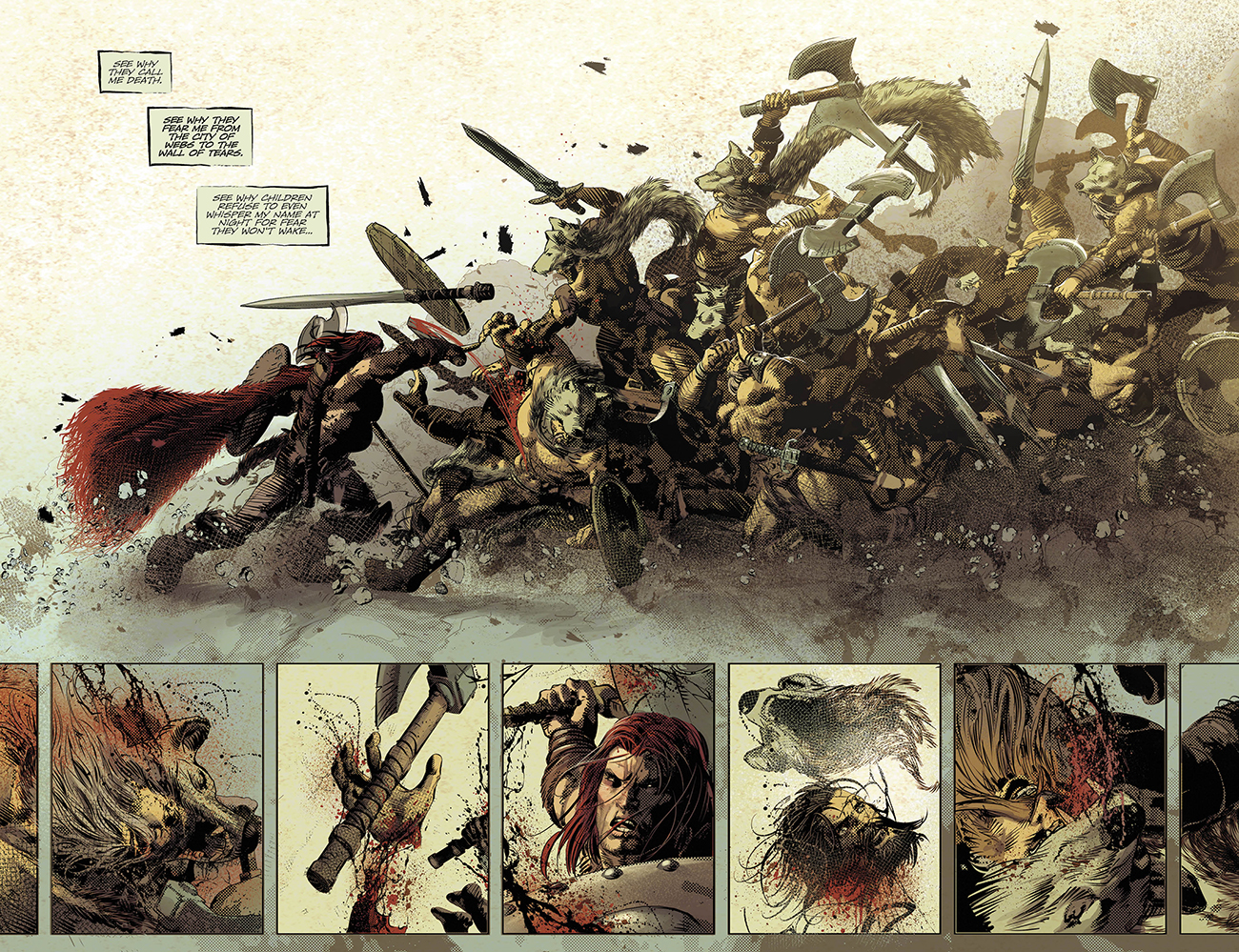
Dueben: Do you see a difference in your mind between the work that you write and draw yourself, and the work that you write for other artists? For you what is it that connects Lost Dogs and Essex County and The Nobody and The Roughneck and Underwater Welder and Royal City?
Lemire: Generally, the stuff I write for others, I develop with that artist I mind. So, I developed Descender specifically for Dustin, likewise Gideon Falls for Andrea. My imagination tends to go in other directions that it may not if I was drawing something myself because I am thinking of things that they (Dustin, Andrea, Dean, etc.) would excel at. Likewise, when I develop something I am going to draw, I know that I am going to draw it as I am fishing for new ideas. So, I tend to develop a certain type of story that suits my strengths as an artist and the things I like to draw.
Now, there are certain themes and ideas that I am just naturally drawn to as a storyteller, so a lot of things pop up in all my work, the stuff I am drawing and the stuff others are. There are certain reoccurring things in all my stuff. But the stuff I draw myself usually tends to be less genre-specific, a little more grounded in the “real” world. Though there are expectations to that, like Sweet Tooth and Trillium, so who knows.
Originally, I planned on drawing Black Hammer. Which may be why it feels a bit closer to some of the stuff I have drawn myself. It’s hard for me to analyze my own stuff though. I feel like all the stuff I do now is very personal even if I am not drawing it. A big part of that is that I mainly do creator-owned stuff now. And when I do work-for-hire, I have to feel really connected to it and know I can put myself into it. There have been more than a few work-for-hire things that I have walked away from over the last few years because I knew I couldn’t put enough of myself into them.
Dueben: Black Hammer: The Age of Doom #12 comes out in July, which ends this volume and I think it’s pretty clear for readers that things will change afterwards and that this is the end of something. People who are reading the trades, know that something big is coming. Just as things changed when the first Black Hammer series ended.
Lemire: The world of Black Hammer has grown into something much bigger than I could ever have dreamed. It is now a world full of potential and new stories. It is with that in mind that the “farm story” – what many consider to be the core story – will end with Black Hammer: Age of Doom #12. This is the ending I always intended for these heroes, and this story, and I am incredibly grateful to all the retailers and readers who have supported Black Hammer and allowed Dean Ormston, Dave Stewart, Todd Klein, and I to tell the story we wanted to tell on our own terms, exactly how we wanted to tell it.
But that is not the end of Black Hammer. It is simply the end of what we can consider “Chapter One.”
In the coming months we will announce a number of new Black Hammer comics; some featuring familiar characters we’ve come to love, and others starring brand new heroes. Dean Ormston and I are already hard at work on our follow-up to Age of Doom—on “Chapter Two” – featuring Lucy Weber as the all new Black Hammer! And we’re excited to share where the world goes next with all of you.
Dueben: I don’t want you to spoil anything, but could you talk a little in broad strokes about what comes next in this universe. More Quantum Age and stories about the century that separates them? More spinoffs like Cthu-louise and Doctor Star that are more tangential? Do you want to let other people play in this sandbox, like Ray Fawkes and Matt Kindt have been doing with Black Hammer ’45? Do you want to draw some of them? What are you thinking about right now?
Lemire: I am open to any and all things. I currently have five new Black Hammer series in the works and they are all very different from one another and from what has already been published. I will continue to write most of this stuff, and will only allow other writers in for very specific reasons. Matt and Ray came in because they are two of my best friends, and I knew it would be fun to do a Black Hammer story with them.
I have one other series that I knew was not my story to tell. It speaks of a perspective that is not mine, and I wanted a writer who could bring an authentic voice and life experiences to it. I have been mentoring a brilliant young writer named Tate Brombal. He helped me with the Black Hammer Encyclopedia and we became friends while working on the Essex County TV show. Tate had a story he wanted to tell that used a certain Black Hammer character to speak to his experiences as a gay man. I think it will really be something special and I am proud to have created a universe where this new, up and coming writer could tell a story that was deeply personal to him. So, if other opportunities like this present themselves, I am very open to that as well.
Honestly, there is no master plan. I am so busy now that I have to fall in love with the story and really want to do it. So, it really is just taking each new piece as it comes to me and continuing to have fun, work with great artists, and tell stories that I am passionate about and I truly enjoy telling.
Black Hammer: Age of Doom concludes with issue #12 this August. To keep up with Jeff Lemire and his work, follow him on Twitter.


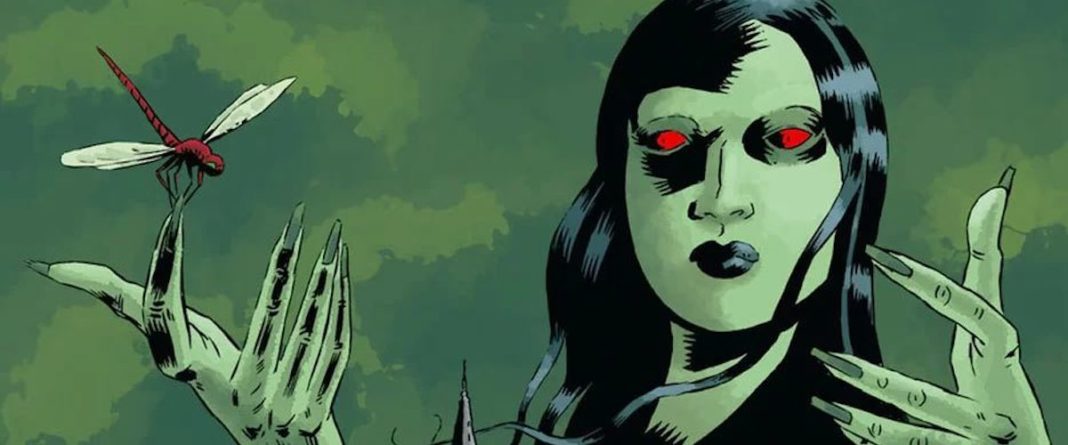
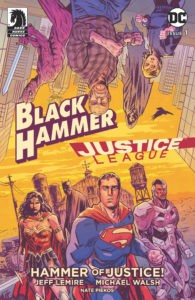
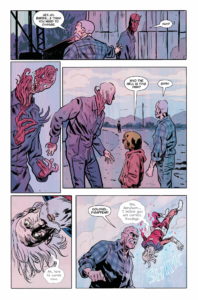
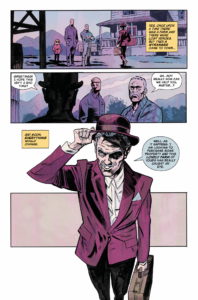






Comments are closed.